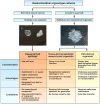Organoid Models of Human Gastrointestinal Development and Disease
- PMID: 26774180
- PMCID: PMC4842135
- DOI: 10.1053/j.gastro.2015.12.042
Organoid Models of Human Gastrointestinal Development and Disease
Abstract
We have greatly advanced our ability to grow a diverse range of tissue-derived and pluripotent stem cell-derived gastrointestinal (GI) tissues in vitro. These systems, broadly referred to as organoids, have allowed the field to move away from the often nonphysiological, transformed cell lines that have been used for decades in GI research. Organoids are derived from primary tissues and have the capacity for long-term growth. They contain varying levels of cellular complexity and physiological similarity to native organ systems. We review the latest discoveries from studies of tissue-derived and pluripotent stem cell-derived intestinal, gastric, esophageal, liver, and pancreatic organoids. These studies have provided important insights into GI development, tissue homeostasis, and disease and might be used to develop personalized medicines.
Keywords: Gastrointestinal Development; Gastrointestinal Disease; Gastrointestinal Regeneration; Gut Organoids.
Copyright © 2016 AGA Institute. Published by Elsevier Inc. All rights reserved.
Conflict of interest statement
Figures


Similar articles
-
[From human pluripotent stem cells to custom-made intestinal organoids].Med Sci (Paris). 2019 Jun-Jul;35(6-7):549-555. doi: 10.1051/medsci/2019096. Epub 2019 Jul 5. Med Sci (Paris). 2019. PMID: 31274085 Review. French.
-
Gastrointestinal organoids: How they gut it out.Dev Biol. 2016 Dec 15;420(2):239-250. doi: 10.1016/j.ydbio.2016.08.010. Epub 2016 Aug 10. Dev Biol. 2016. PMID: 27521455 Review.
-
Gut organoids: mini-tissues in culture to study intestinal physiology and disease.Am J Physiol Cell Physiol. 2019 Sep 1;317(3):C405-C419. doi: 10.1152/ajpcell.00300.2017. Epub 2019 Jun 19. Am J Physiol Cell Physiol. 2019. PMID: 31216420 Free PMC article. Review.
-
Gastrointestinal organoids: a next-generation tool for modeling human development.Am J Physiol Gastrointest Liver Physiol. 2020 Sep 1;319(3):G375-G381. doi: 10.1152/ajpgi.00199.2020. Epub 2020 Jul 13. Am J Physiol Gastrointest Liver Physiol. 2020. PMID: 32658619 Free PMC article. Review.
-
The promise of human organoids in the digestive system.Cell Death Differ. 2021 Jan;28(1):84-94. doi: 10.1038/s41418-020-00661-3. Epub 2020 Nov 17. Cell Death Differ. 2021. PMID: 33204011 Free PMC article. Review.
Cited by
-
Revisiting fibrosis in inflammatory bowel disease: the gut thickens.Nat Rev Gastroenterol Hepatol. 2022 Mar;19(3):169-184. doi: 10.1038/s41575-021-00543-0. Epub 2021 Dec 7. Nat Rev Gastroenterol Hepatol. 2022. PMID: 34876680 Review.
-
Human organoids in basic research and clinical applications.Signal Transduct Target Ther. 2022 May 24;7(1):168. doi: 10.1038/s41392-022-01024-9. Signal Transduct Target Ther. 2022. PMID: 35610212 Free PMC article. Review.
-
Acid and the basis for cellular plasticity and reprogramming in gastric repair and cancer.Nat Rev Gastroenterol Hepatol. 2018 May;15(5):257-273. doi: 10.1038/nrgastro.2018.5. Epub 2018 Feb 21. Nat Rev Gastroenterol Hepatol. 2018. PMID: 29463907 Free PMC article. Review.
-
The Imperative for Innovative Enteric Nervous System-Intestinal Organoid Co-Culture Models: Transforming GI Disease Modeling and Treatment.Cells. 2024 May 10;13(10):820. doi: 10.3390/cells13100820. Cells. 2024. PMID: 38786042 Free PMC article. Review.
-
Generation of 3D human gastrointestinal organoids: principle and applications.Cell Regen. 2020 Jun 10;9(1):6. doi: 10.1186/s13619-020-00040-w. Cell Regen. 2020. PMID: 32588198 Free PMC article. Review.
References
-
- Sinagoga KL, MKW, Wells JM. Multiple factors affecting the differentiation of human enteroendocrine cells. Endoderm Lineages in Development and Disease Keystone Symposium; 2015; Keystone, CO.
-
- Spence JR, Wells JM. Translational embryology: using embryonic principles to generate pancreatic endocrine cells from embryonic stem cells. Dev Dyn. 2007;236(12):3218–27. - PubMed
Publication types
MeSH terms
Grants and funding
LinkOut - more resources
Full Text Sources
Other Literature Sources

